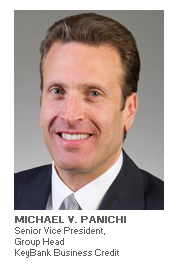
In this first 2024 installment of this quarterly ABL Advisor article series, Charlie Perer sits with commercial finance industry participants to discuss the state of the ABL industry and general market dynamics. The objective of this series is to engage with a group of commercial finance leaders who cover the spectrum of lending, turnaround advising, and capital raising to ascertain their views and how they are positioning their business for success.
Here to tell the story are Michael Panichi, SVP, Group Head of KeyBank Business Capital, Stephen Beriau, Senior Managing Director of Eclipse Business Capital, Tom Lesch, Partner of Livingstone, and Winston Mar, Partner of CR3 Partners.
Charlie Perer: Please briefly introduce yourselves.

Michael Panichi: I am the Group Head of KeyBank Business Capital. Our team provides asset-based lending solutions to middle-market and large companies nationally for a wide variety of ongoing and event-driven needs, ranging from acquisitions, dividend recapitalizations, seasonal and/or turnaround profiles. As part of KeyBank’s Debt Capital Markets Group, we have expertise in providing comprehensive solutions from simple to complex debt structures.
Tom Lesch:Thank you for the opportunity to join the panel, Charlie. I am a Partner at Livingstone Partners, where I have led our Debt Advisory practice for the past 12 years. Livingstone Partners is a global M&A and Debt Advisory firm with 100 employees across ten offices (two in the U.S., one in China, one in South Korea, and seven in Western and Northern Europe). Our M&A practice constitutes approximately 75 percent of our overall business volume, with Special Situations (Distressed M&A) and Debt Advisory comprising the remaining 25 percent. The deals we engage in fall within the $20 million to $500 million range, catering to private equity-backed and family businesses.

Stephen Beriau: I serve as a Senior Managing Director for Eclipse Business Capital, a non-bank finance company focused on providing asset-based loans between $15 and $200 million. I am responsible for sourcing and structuring new transactions in the Midwest region. I joined Eclipse as a Managing Director and Senior Underwriter in 2016 after holding underwriting, credit and field exam roles with Cole Taylor/MB Financial and Bibby Financial Services.
Winston Mar: I am a Partner at CR3 Partners based in Los Angeles. I have been in the restructuring industry for over twenty years, dealing with a wide variety of industries including advertising and marketing, energy, entertainment, computer products and services, food and agricultural products, manufacturing and restaurants. I have experience in both out-of-court and Chapter 11 proceedings and have served in a variety of senior-level positions, including CRO and CEO.
Perer: How would you describe the current market environment through the lens of your own business?

Lesch:We have seen a pickup across all three lines of business: M&A, Special Situations, and Debt. For healthy sell-side engagements we are seeing both PE and Strategics interest in the deals we are bringing to market. Seller expectations have been reset a bit, while buyers understand that being a first mover likely means they are buying at a more attractive multiple as opposed to waiting for the market to rise. Our Special Situations group has ramped up significantly since Q1 2023. We will touch on the drivers of this later in the discussion, but banks are more actively managing their workout credits, which drives opportunities for our Debt and Special Situations practices. Our pipeline of active engagements across all three business lines is robust, with several near-term deals expected to close prior to the end of Q1 2024. I should also point out we are slightly different from most investment banks we compete against in that we are much more private company-focused as opposed to relying on PE-backed deal flow.

Mar: What we are seeing, at least with regulated lenders, is more activity in terms of distressed deals and higher overall deal volume than in prior years. We are also seeing lenders that are becoming much more active in dealing with poorly performing loans. In 2023, our inbound leads from companies funded by regulated lenders were higher than in 2022 by over 35 percent.
Panichi: I would say cautiously optimistic. The anemic activity in 2023 has many financial institutions seeking increased volume for 2024. However, the theme will be targeted growth with continued focus on capital levels and liquidity, especially given the proposed regulatory changes. We are seeing evidence of a pick-up in M&A and macro-economic conditions still show signs of resiliency, albeit some weakness in certain consumer segments.
Beriau: Trending positively, we are seeing more transactions driven by restructurings and traditional refinancing activity. While the first half of 2023 was active for the number of deals reviewed, many of the transactions would require lenders to act as equity in the capital stack. These early transactions needed a complete balance sheet restructuring but were short on resources and capital.
Perer: Entering Q1 2024, where is deal flow both in terms of quality and quantity compared to this time last year?
Panichi: While deal flow picked up somewhat late in the second half of 2023, we did notice a considerable change in mix towards more challenged credits as banks seemingly sought to purge undesired relationships. Going into the tail of 2023 and into the start of 2024, we are beginning to see a shift back towards quality of opportunities, likely in part from those borrowers that sat idle in 2023. The message to the client base last year was not to ask for any additional capital unless you really needed it, given the likelihood of the need to increase pricing. For performing companies with growth opportunities, capital needs will persist through 2024.
Lesch: Deal flow is up. As many saw, Q4 was pretty active, and we are seeing both M&A and financing rebound a bit from the depths of Q2 and Q3 2023. According to LPC’s Private Deal Analysis, loan volume in Q4 was up 31 percent over Q3 and up over Q4 2022. The combination of healthy M&A getting back on track and banks proactively working out their distressed portfolio has led to increased loan volume in the middle market. While nowhere near the peaks of 2021, loan volume was up substantially in Q4 2023 over Q3.
Beriau: Improving; we saw more opportunities in 4th quarter that had either a route to restructuring or the availability needed to effectuate a successful turnaround. These businesses typically had recovering revenues or were able to completely exit product with higher landed costs, while having sufficient availability to bring in newer product.
Mar: Our firm has hired more people to compensate for the increase in work, we are relatively full in terms of capacity, and we continue to hire more people in 2024 as we anticipate additional growth in our deal flow, both in terms of the number of clients as well as the complexity of our engagements. We are also assessing what areas we could be effective in terms of deal structure to facilitate a better outcome.
Perer: Did the banking crisis of 2023 change how both banks and non-banks handle covenant breaches?
Beriau: Banks were changing how they handled covenant breaches well before the banking crisis, but it may have further shortened timelines for borrowers. We are seeing more notices of default and tighter timelines for refinancings due to the impact these credits have on capital ratios.
Lesch: The banking crisis certainly was a dose of reality for workout groups and special asset units. Banks need to manage businesses that miss covenants more actively. While it is understandable to be sympathetic to the first covenant breach, after two quarters, work-out lenders need to manage distressed credits actively; if they don’t, it is usually too late, and a refinance becomes impossible. While non-bank lenders generally have flexible underwriting standards, these groups are better at supporting good businesses with bad balance sheets, not bad businesses. Non-bank lenders cannot be expected to simply fix every bank workout credit that comes along.
Panichi: I don’t believe much has changed in terms of how a bank handles an underperforming borrower. Historically, it’s always been a function of an institution’s aggregated portfolio composition and assessment of the level of existing and potential stress in the book. What has changed is the focus on building capital and liquidity to meet newly proposed requirements. This will be another consideration as to which relationships are desired or not as well as the carrying cost of riskier loans.
Mar: Coming out of COVID-19, the OCC (Office of the Comptroller of the Currency) and other agencies issued a memorandum that allowed banks to be more lenient with respect to its loans to struggling companies. However, this relief expired in 2022 and banks became much more aggressive on covenant breaches, which we have seen through 2023 and into 2024.
Perer: Are lenders more quickly and aggressively handling workout credits?
Beriau: Yes, the impact of TDR’s (Troubled Debt Restructuring) on bank capital ratios and subsequent earnings has banks preparing to exit credits sooner. The most recent SFNet Quarterly Asset Based Lending Index shows bank Criticized and Classified Loans as a percent of Total Loans Outstanding increasing from 6.2 percent in Q2 2022 to 14.5 percent for the same period in 2023.
Lesch: They are, and they should. If they do not actively manage those borrowers, the chances of a refinance at par are significantly diminished. In 2023 it was noticed that both banks and non-banks became more active in managing credits. For banks, the insistence on putting in restructuring advisors became more common. While on the non-bank side we have seen a significant increase in lenders exercising their right to “Vote the Shares” and replace the board of directors at the borrower. Years ago, this move was almost more theoretical and rarely used; however, in today’s workout environment we are seeing it deployed with some regularity.
Panichi: There did appear to be a push in the second half of 2023 for the banking community to exit undesired relationships or risk-off undesired asset compositions, especially in segments that showed signs of weakness or term loans with little or no depository relationship. Given both the current economic environment and increased non-bank funding sources offering more aggressive structures, borrowers who do not fit a traditional bank structure have options, and a refinance can be the quickest way for a resolve for all parties.
Mar: We are seeing that lenders are getting engaged sooner. This is a positive for turnaround firms and professionals because we can do more for the company if we are engaged sooner. When companies have us come in sooner, our hope is that we can fix a company and preserve more value, instead of selling it or pursuing a liquidation if we are brought in too late.
Perer: Please compare and contrast the 2021 credit environment to 2023?
Panichi: The credit environment of 2021 versus 2023 were vastly different. In 2021, banks were trying to sift through lots of noise. Quantitative Easing, including direct checks and PPP funds propped up both consumers and businesses, respectively. Banks were focused on core earnings and risk that PPP funds were a temporary fix or masking other problems. Supply chain disruptions were also prevalent, and in many cases causing sales disruption. This led to excess inventory supplies in 2022, at higher costs, as business overcompensated to ensure continuity of sales and production. What became more apparent entering 2023 was a demand shift, especially in the consumer as they pivoted to services at the expense of household/discretionary goods. In 2023, destocking and inventory values and reliance on those assets in the borrowing base became a focal point, as did imbedded losses and the impact to earnings given deflation from prior transitory spikes.
Lesch: Basically it’s night and day. 2021 was one of the best years for M&A and debt, while 2023 was bleak, with M&A and debt issuance levels down considerably. LPC cited middle market loan volume in 2023 was down 33 percent from the peak of 2021. In 2021 M&A multiples were coming out of Covid and exploded, which led to debt multiples increasing. With debt volume up and interest rates low, deal structures also got pushed with borrower friendly accommodations throughout credit agreements. In 2023, in a higher rate environment, and with M&A volume significantly curtailed, lenders brought leverage down and significantly increased the strength of the credit agreements.
Beriau: In 2021 companies were able to buy time with their lenders because of federal monetary support and relaxed bank regulation for downgrades. With the end of federal support in 2023 we saw a step towards the more typical credit cycle for borrowers of steady state, contraction, operational improvement and expansion.
Mar: One of the unintended consequences of monies being distributed through PPP and similar programs through 2021 was that it gave companies breathing room to avoid dealing with many of their underlying operational and management issues, in addition to pushing off their lenders. Now, we are seeing lenders having more freedom to decide if they truly want to work out underperforming credits or force the borrower to refinance.
Perer: How do any of the lessons learned over the past few years inform your decision making starting 2024?
Panichi: Each market disruption has some level of uniqueness and provides insights on how to better manage risk prospectively. For instance, supply chain issues heightened awareness on alternative vendor sourcing as well as carrier and route options. The pivot in demand in certain segments also warrants greater reflection on watching for bubbles and trying to stay ahead of the cycle or boxing in risk earlier to ensure a soft landing.
Lesch: As we saw both M&A and Debt rebound a bit in Q4 2023, I predict Q1 and Q2 will continue with this momentum. So, while lenders likely have changed some habits, namely more actively managing workout credits, I think you are going to see a strong market on the new issuance side.. Lenders will compete to win mandates, pushing spreads down and looser structures. In many ways it’s a tale of two markets with banks migrating to only booking strong new credits and managing how to exit marginal deals.
Mar: We prefer to start cases before the company is entirely distressed and is unable to make payroll. We are starting to see banks agitating for change in anticipation of covenant defaults, as opposed to in prior years in which banks would wait for financial defaults to occur before taking action.
Beriau: 2023 further proved EBC’s mission that our pre-proposal diligence process is important because it ensures a comprehensive structure that works for the client and provides certainty for our intermediaries. No facility is one size fits all and waiting until due diligence to finalize structure is detrimental to all stakeholders.
Perer: Do you anticipate more new deal activity from the sponsor universe or bank transitions or exits?
Lesch: Several larger middle-market sponsors recently closed on multi-billion dollar fundraises. This dry powder, coupled with existing equity that was on the sidelines during 2023, should make for robust auctions where price and speed will be the recipe for winning a sale process. When purchase price multiples increase, leverage undoubtedly increases. As mentioned above, workout lenders are more actively managing troubled credits, so the distressed workout volume should also be up. Our Special Situations Partner, Joe Greenwood, has been tremendously active over the past 12 months. Together, Joe and I expect a fair amount of lending activity for distressed workout exits. I also anticipate a fair amount of deal flow from add-on acquisitions. So, for my line of business, both the healthy and distressed sides are expected to be strong this year.
Beriau: Exits, while we have many sponsor-owned companies in our portfolio, almost all of those transactions were driven by changes in credit profile. M&A activity was down significantly in 2023 and I do not expect a rebound in 2024.
Mar: Our firm has historically had an above-average proportion of deal flow from equity sponsors, as we have several colleagues with operational-restructuring and performance-improvement skill sets in addition to financial restructuring. We are speaking to more sponsors in terms of their situations and how they can improve them, but the plurality of our incoming leads and eventual clients comes from secured lenders, although those clients are themselves for the most part sponsor-backed or otherwise closely held. We are also seeing more work from banks who want to exit credits.
Panichi: There definitely is an expectation of increased sponsor activity. It is more likely this year that buyers and sellers will find a new value equilibrium, spurring M&A. Growth should also be precipitated simply by maturing funds, which will force sponsors to monetize existing portfolios and raise capital to deploy for new opportunities. To the extent we do see some relief in cost of funds, this will also contribute to an increase in activity. Roughly 20 percent of our relationships are sponsor driven, so we have strong familiarity with this investor group.
Perer: Have banks finally shifted to a risk-off mode that should benefit the ABL market?
Beriau: While there were a few banks focusing on protecting capital in 2023 either due to acquisitions or the regional banking crisis, the entire market has not shifted to risk off. I’ve seen numerous transactions closing with regional and national banking institutions that were arguably borderline credits, because they were well capitalized during the regional crisis, and ABL is one of their key product offerings.
Panichi: There is no shortage of private credit continuing to enter the market as secured lenders or otherwise. In 2023, we saw banks focus on de-risking either aggressive structures or specific assets through the non-bank lenders. The expectation is for this to continue into 2024, but at the same time allowing for funds to be reconstituted to more desired relationships, certainly with a continued focus on depository relationships and ancillary business.
Mar: No, banks are still taking some risks. In terms of the ABL market, they still want to work with companies, contingent upon whether the companies can return to a situation where the business is running properly.
Lesch: I have noticed banks have pulled back on ABL. Ten years ago, the bank-led ABL environment was extremely aggressive. Over the past year, commercial bank ABL groups have become less aggressive and retreated to more conventional structures. Banks doing significant air balls and aggressive stretch pieces are few and far between in today’s market.
Continued on Page 2...